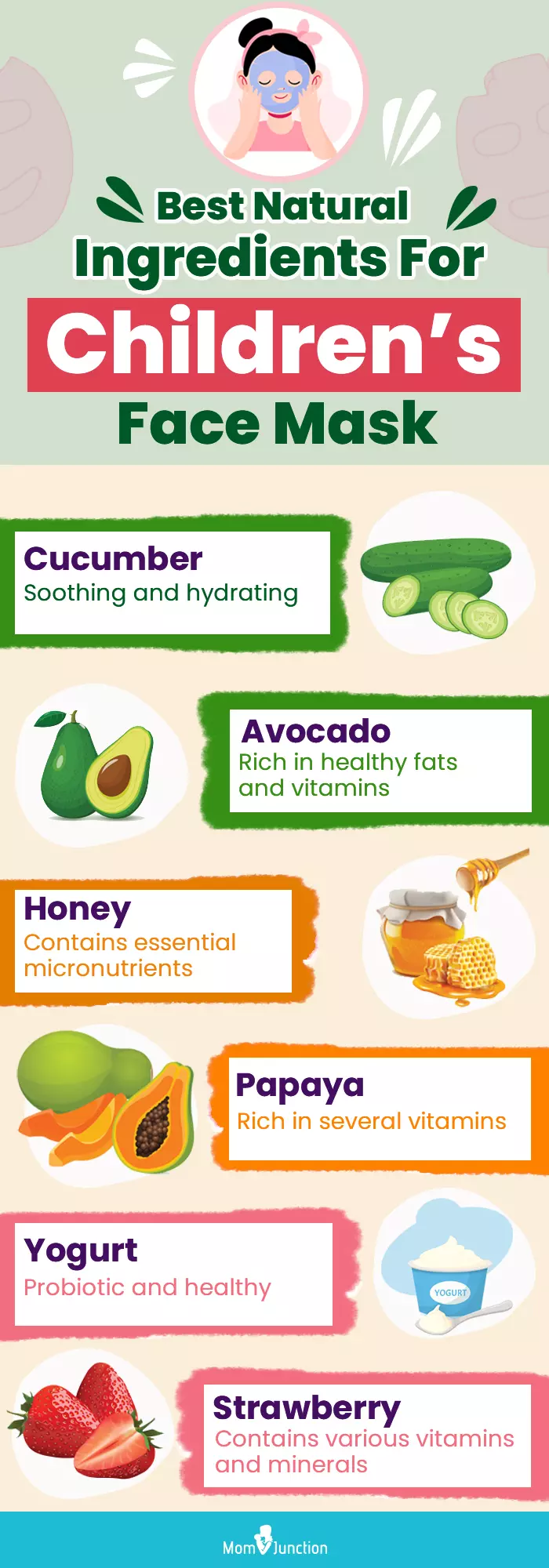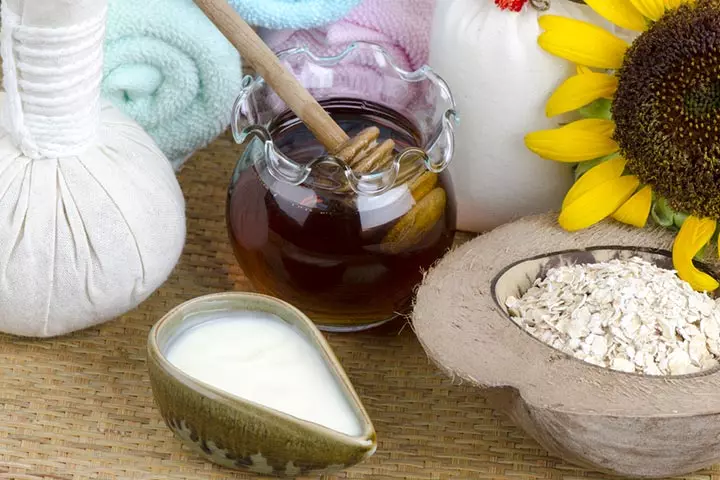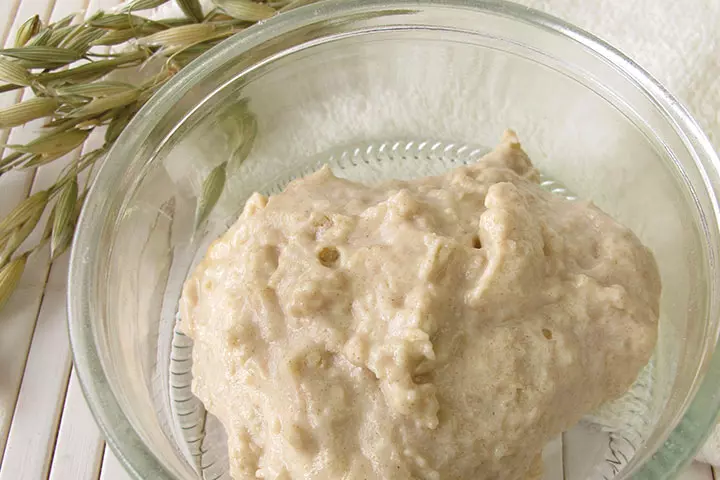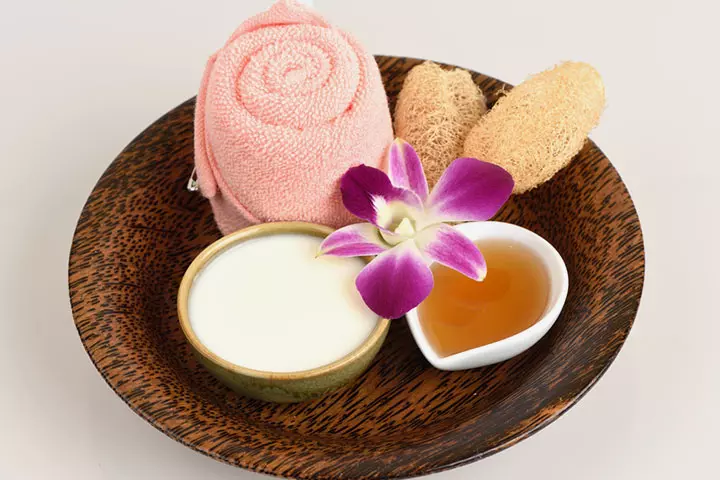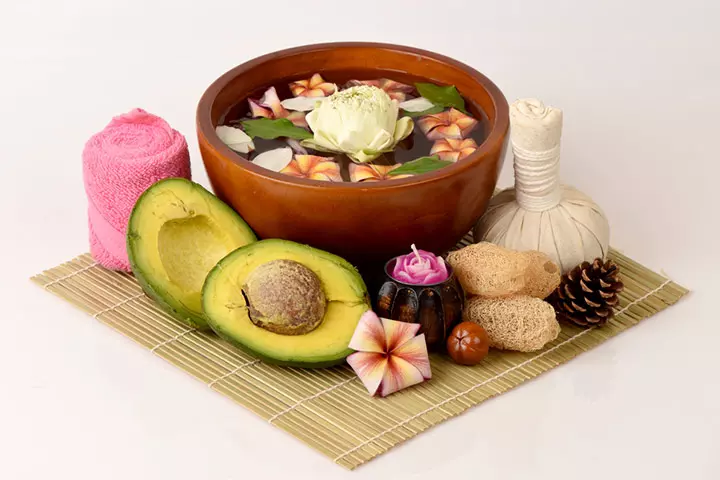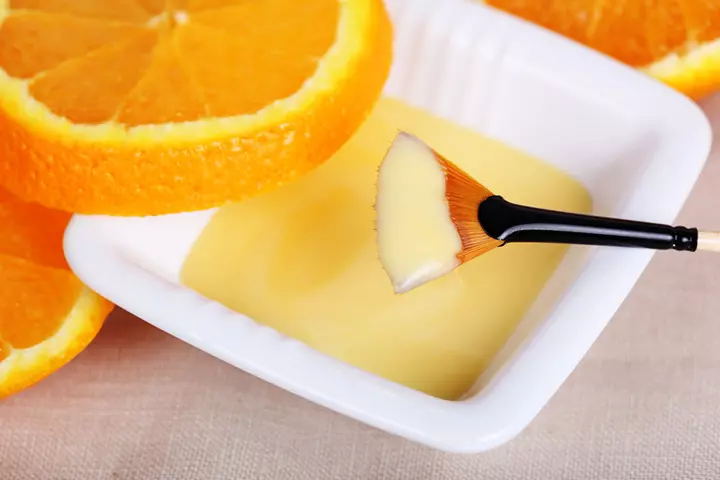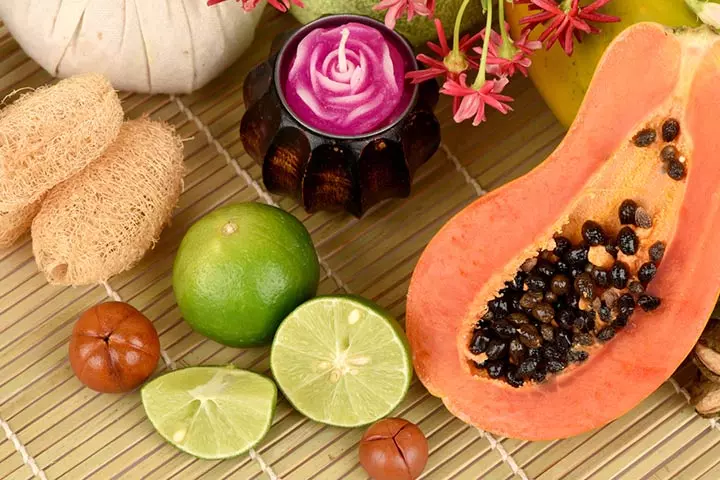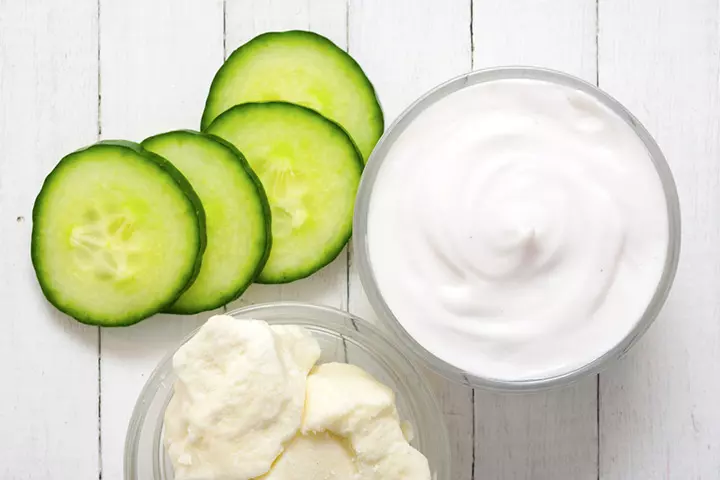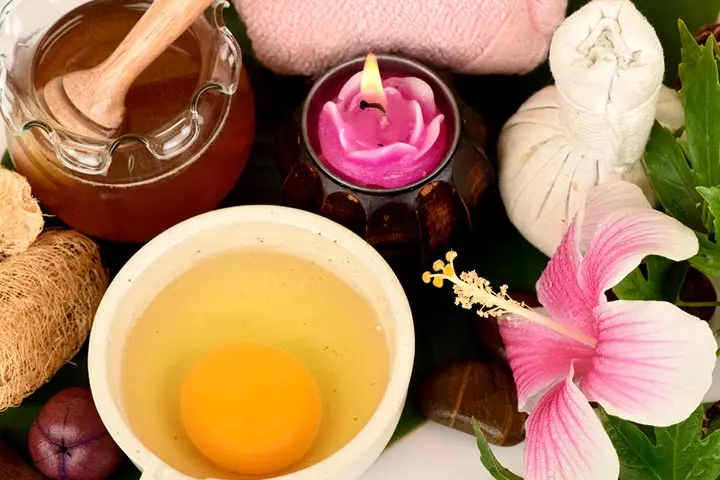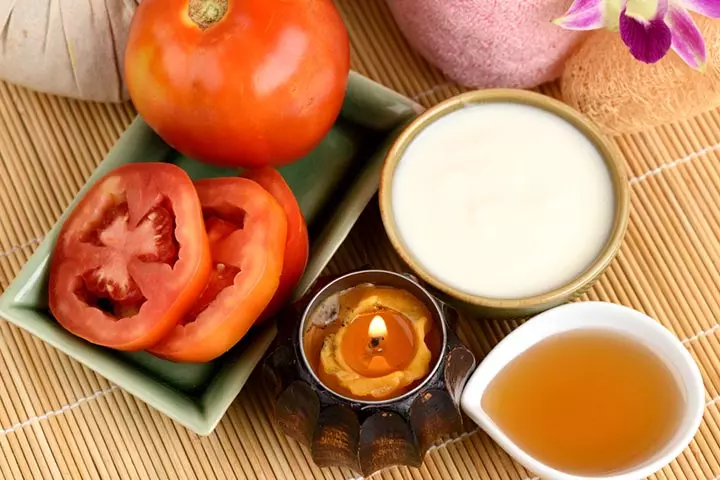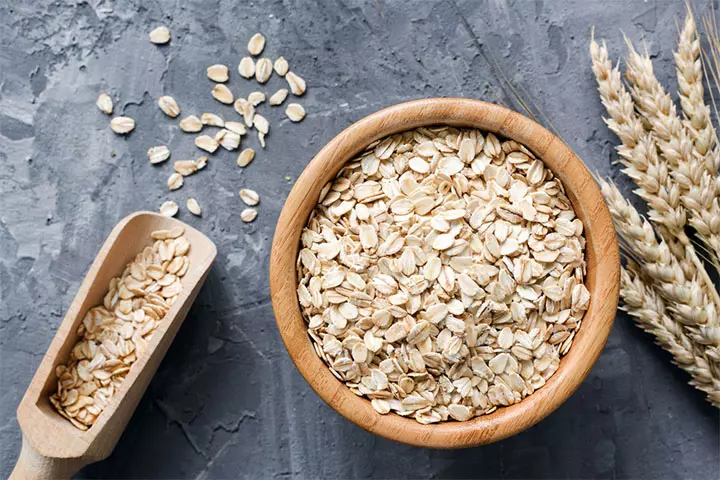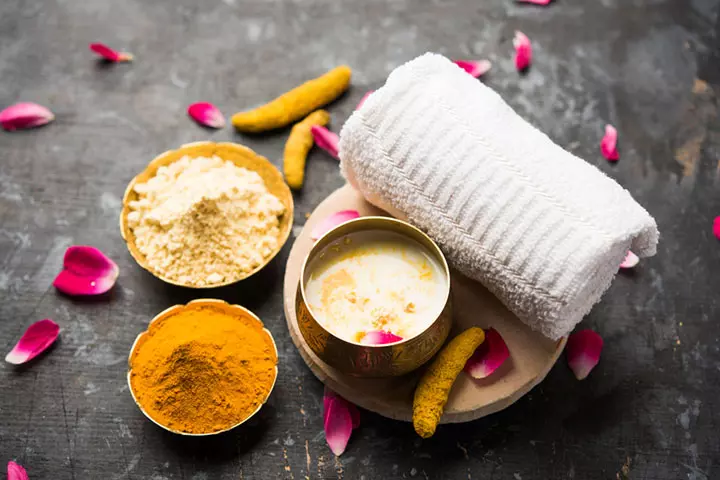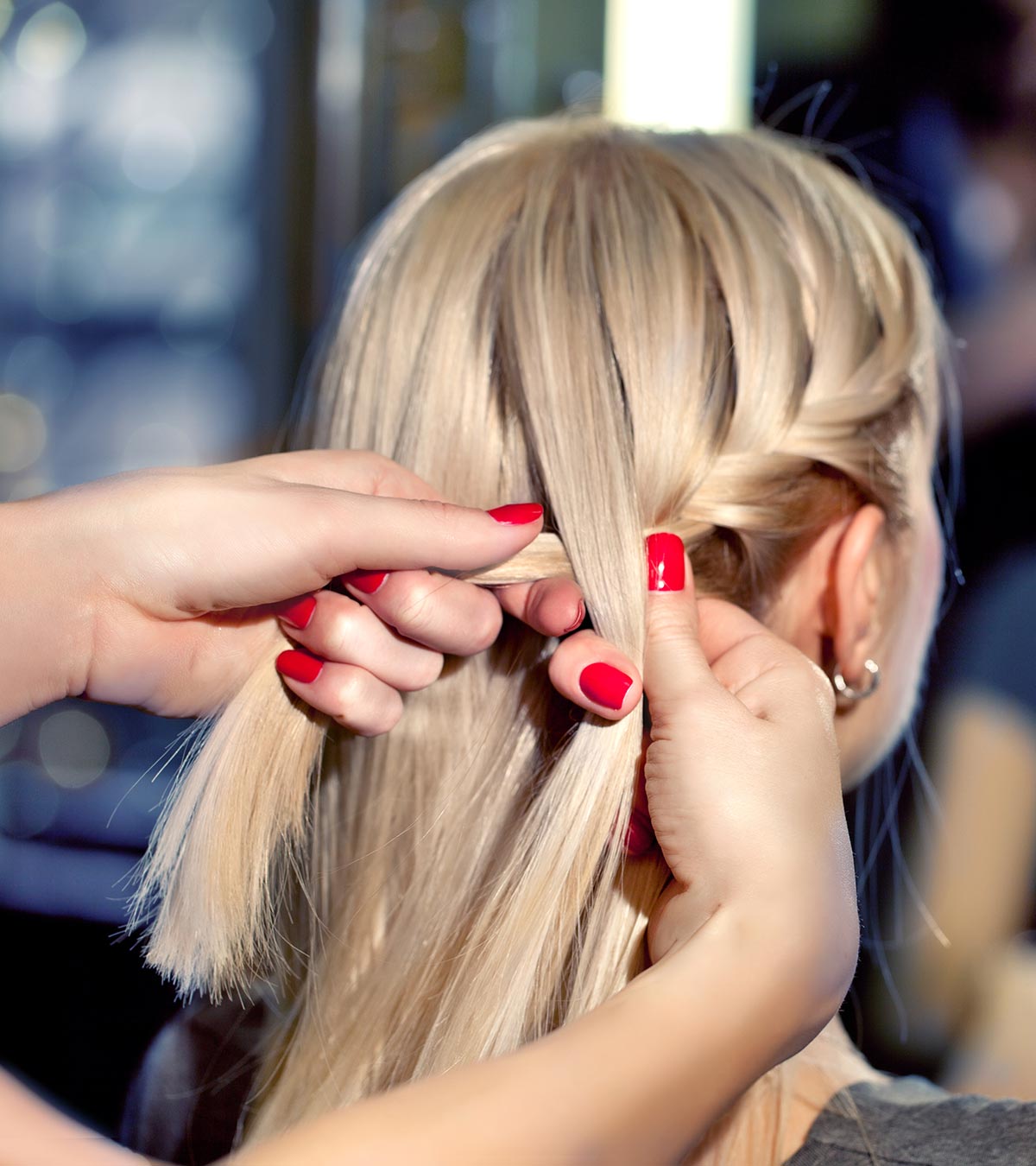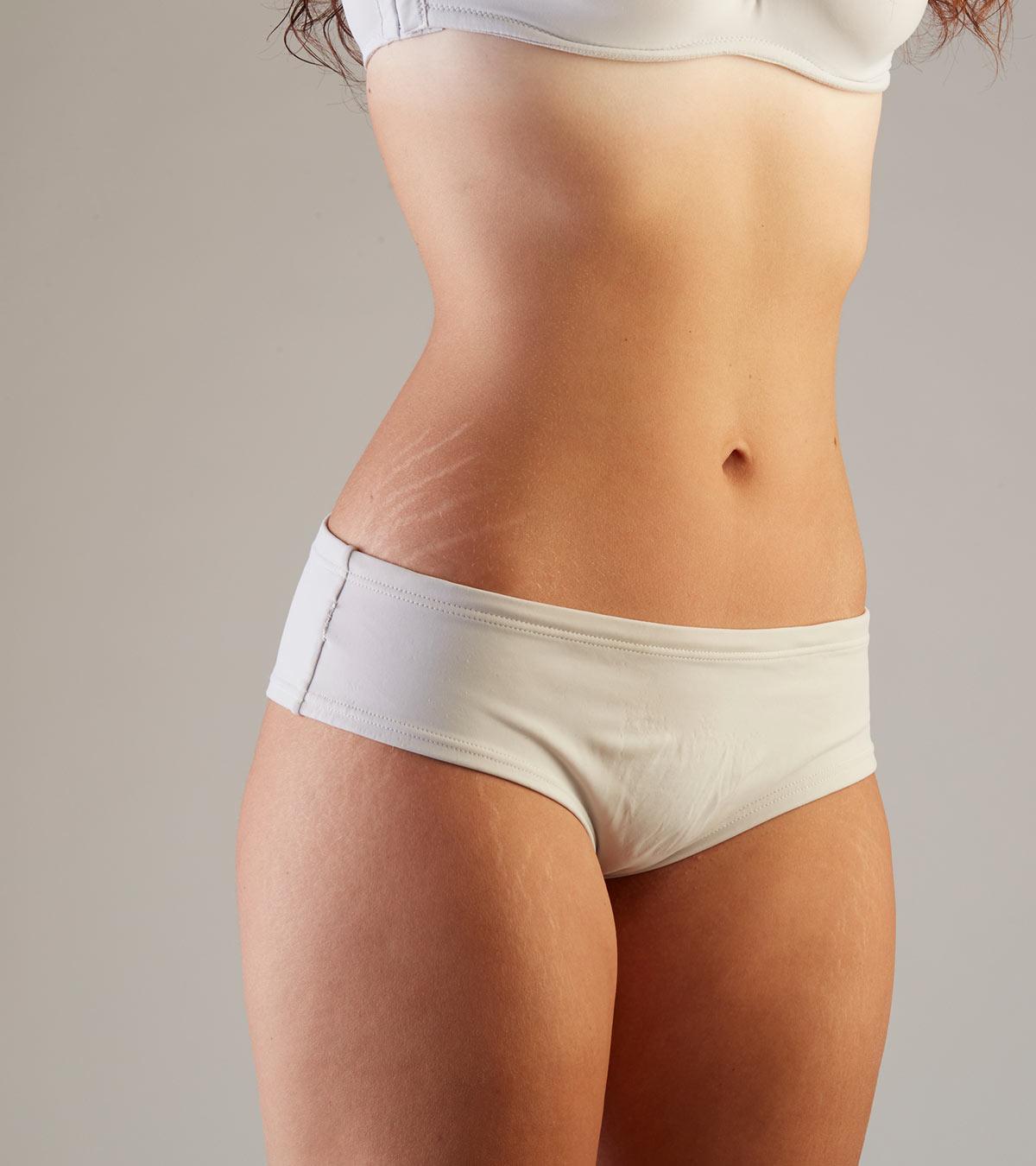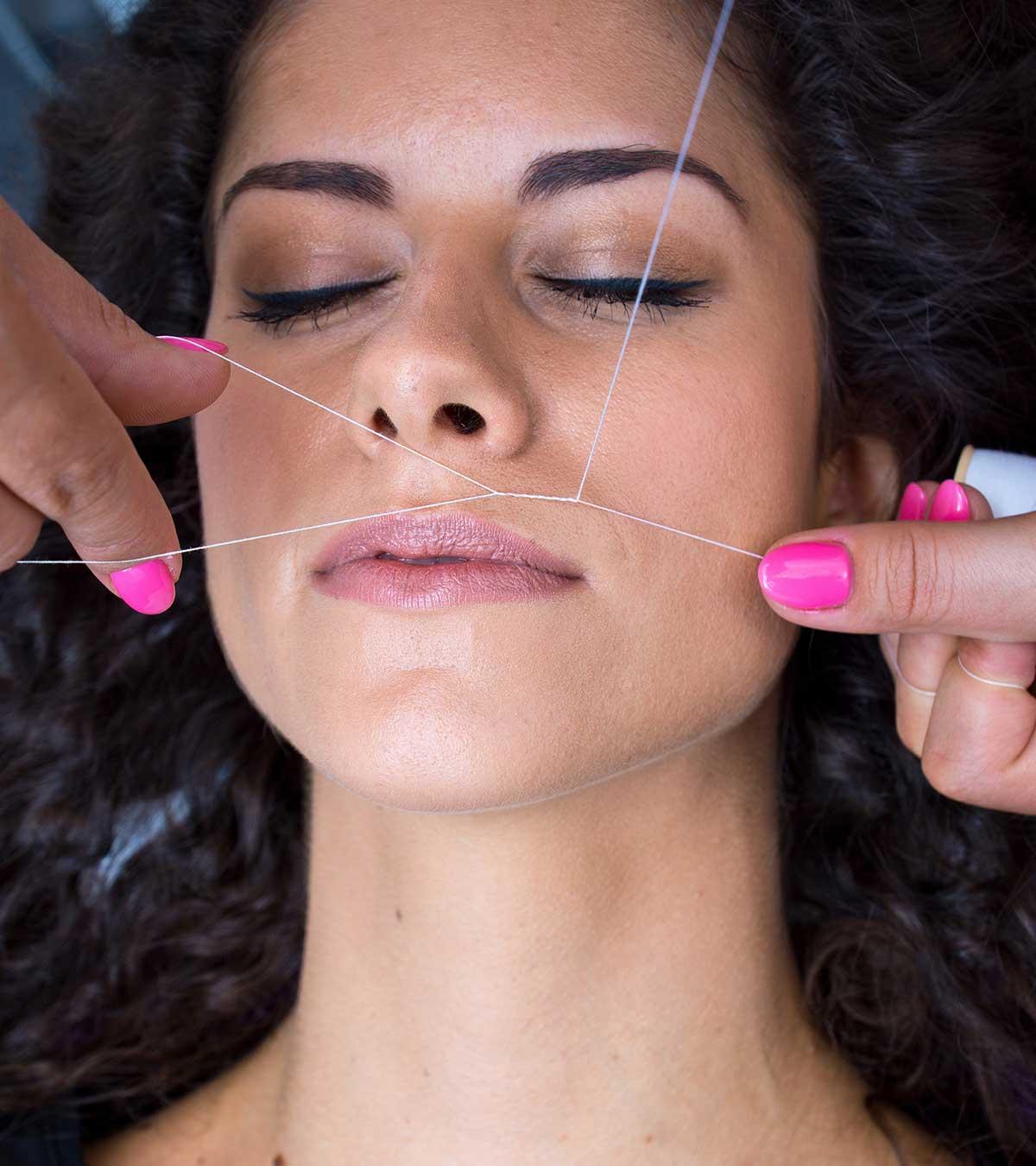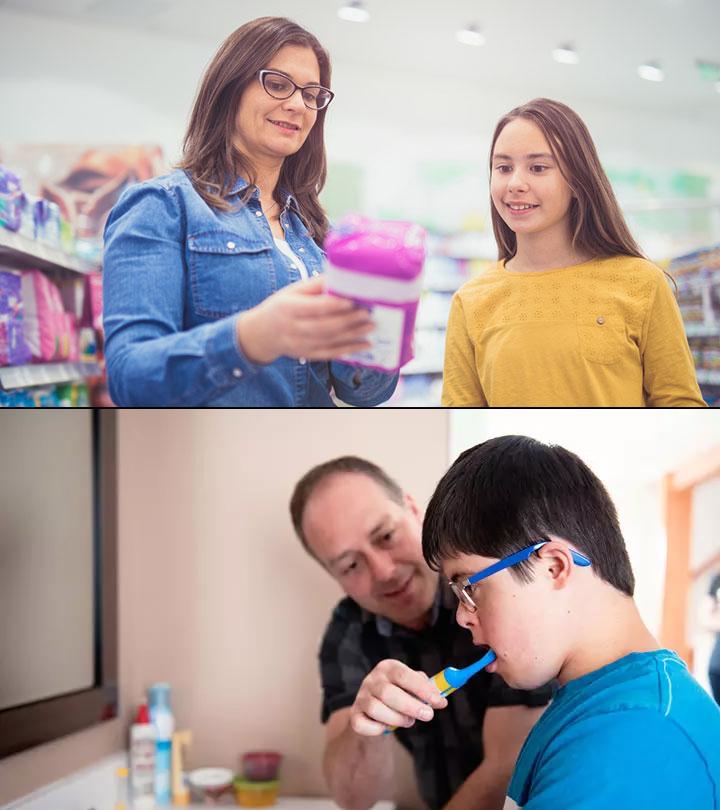
Image: Midjourney/ MomJunction Design Team
Children are exposed to dust, pollution, and other skin irritants every day. Homemade face masks for kids offer a fun and interesting way to cleanse, protect, and nourish their delicate skin, with simple ingredients that you can easily find in your kitchen. Just as you enjoy a relaxing face mask, your children can enjoy the bliss of rejuvenation with DIY kids face masks. Homemade face masks are generally safe for your child’s delicate skin as they usually do not have harsh chemicals. All you have to do to create homemade masks for kids is mix ingredients found in the kitchen pantry. However, ensure that the ingredients you add to the face pack are gentle, safe, and suitable for your child’s skin. Keep scrolling as we tell you some simple and effective ways to make facial masks at home.
Key Pointers
- Applying a face mask can improve skin suppleness, cleanliness, and hydration.
- You can use natural ingredients like honey, avocado, cucumber, and yogurt for homemade face masks.
- Homemade face masks can clear pores, enhance hydration, diminish fine lines, even skin tone, and promote relaxation.
- Before applying the mask, make sure your child has cleansed their face well.
- Face masks suitable for kids include oatmeal scrub, yogurt face mask, avocado face mask, orange face mask, and cucumber face mask.
What Is A Face Mask?
A face mask or facial face mask is a paste that can help cleanse, tone, exfoliate, and massage your kid’s skin. A quality face mask should contain natural ingredients that help tackle minor skin conditions. For instance, if your child has dry skin, the ingredients should hydrate their skin. If they have skin rashes or pimples, the mask should have soothing ingredients. And, if your child has oily skin the facial mask should draw out impurities from the skin.
Are Face Masks Safe For Kids?
Most homemade face masks for kids contain gentle ingredients to hydrate and cleanse a child’s skin. However, since children’s skin is thinner and more susceptible to inflammation than adults, it’s best to perform a patch test or consult a dermatologist before applying a mask to your child’s face (1).
Infographic: Natural Ingredients Used In Homemade Mask
Illustration: Momjunction Design Team
Natural Ingredients Used In Homemade Face Mask For Kids
Here are some of the most commonly used natural ingredients in homemade facial masks.
1. Cucumber
Cucumber has efficient cooling, healing, and soothing effects and is often used as a natural eye-pad during facial treatments. A blend of cucumber and other natural ingredients like honey or yogurt can serve as a refreshing face mask for your kid’s skin.
2. Avocado
Being rich in vitamins A, B1, B2, D, and E and other essential oils, avocado could be perfect for dry and sensitive skin.
3. Honey
Honey has effective skin tightening, toning, and hydrating effects.
4. Papaya
The protein-digesting enzymeiProtein that helps regulate chemical reactions in the body , PapainiAn enzyme present in papaya that helps digest protein present in raw papaya can help remove dead skin cells. However, papaya should be avoided when your child’s skin is irritated or sunburned.
5. Yogurt
The natural lactic acidiA chemical produced by muscle and red blood cells while generating energy and also found in sour milk products and legumes in yogurt aids in exfoliating your child’s skin. It serves as one of the best skin-softening face masks and is suitable for all skin types.
Besides these ingredients, you may also consider oatmeal, banana, aloe vera gel, lemon juice, strawberry, and green tea for making homemade face masks for kids.
How To Make A Homemade Face Mask For Your Kid?
Check out this simple step-by-step guide to prepare a homemade kid-friendly face mask.
You will need
- Mixing bowls
- Measuring cups
- Wooden spoons
- Plastic container with lid
- Honey
- ¼ cup oatmeal
- ½ cup yogurt
How to
- Gather all the ingredients on your kitchen table and instruct your child to wash their face with soap and water.
- Pour two tablespoons of lukewarm water into the oatmeal in a separate plastic container and cover the lid for about ten minutes.
- Next, mix one tablespoon yogurt to the warm oatmeal mixture and let it cool.
- You may add honey and yogurt to the oatmeal for skin softening.
- Apply the homemade oatmeal-based face mask to your child’s skin. Focus on the areas such as the forehead, cheeks, and nose.
- Ask your child to wash off the face mask using plain tap water and wipe their face with a cotton pad.
 Quick tip
Quick tipBenefits Of Homemade Face Mask For Kids
A homemade face mask can nourish and replenish your child’s skin while adding glow and keeping it fresh. Here are some of the benefits of applying a face mask.
1. Refine skin pores
- A face mask helps your child attain clearer skin, as it cleanses the pores and lowers the risk of developing pimples.
- It loosens blocked pores and helps wash away particles like metabolic wastes and oily elements.
2. Enhances hydration
- Face masks can moisturize and hydrate your child’s skin if they have dry skin.
- The water in the face masks can help improve the skin’s elasticity.
- As the skin gets proper hydration, it becomes more elastic, softer, and glowing. It also makes your child’s skin look youthful and vibrant.
3. Diminishes fine lines
- Regular application of face masks can help reduce skin issues such as wrinkles, dark spots, and fine lines
- Homemade face masks can also make your child’s skin softer and smoother.
4. Evens the skin tone
- Face masks help reduce hyper-pigmentation, resulting in even skin tone and texture.
- Some natural ingredients in the face mask can also enhance the functioning of the sweat glands and increase the oxygen content of the skin.
5. Firms up the skin
- Certain natural face masks help in increasing collageniProtein that provides structural support to connective tissues with its fiber-like structure production. Collagen fights free radical damage and gradually makes skin tighter and firmer (2).
6. Relaxes the skin
- One of the best benefits of a natural face mask is that it helps relax your child’s skin.
- The soothing natural ingredients such as cucumber, papaya, and yogurt can ensure your child’s skin gets pampered and de-stressed.
It also allows parents to be involved with their children and have a beneficial time in a fun activity about skincare. Additionally, this activity will help promote good and healthy habits in your children from a young age.
Different types of homemade face mask for kids
1. Oatmeal scrub
You will need
- ¼ cup of regular oatmeal
- 1 cup water
- 1tbsp honey
How to
- Combine all the ingredients in a plastic bowl and mix well to obtain a smooth paste. You can also use lukewarm water to soften the oatmeal.
- Spread the mixture over your child’s face, but avoid applying the paste around their eyes and mouth region.
- Let the face mask dry for 15 minutes and then make your child wash their face with lukewarm water.
- The oatmeal scrub exfoliates dead skin and helps remove excess oil that may cause acne in kids.
2. Yogurt face mask
You will need
- 1tbsp plain yogurt
- 1tbsp warm honey
How to
- Yogurt serves as a natural cleanser, and it can also moisturize your child’s skin. After the application of yogurt, their skin may feel more smooth and soft.
- Mix equal quantities of plain yogurt and warm honey in a ceramic bowl.
- Spread the mixture evenly on your child’s face, avoiding the mouth and eyes.
- After ten minutes, ask your child to wash their face with lukewarm tap water.
- Your child may apply the face mask twice a day, especially if they have oily skin. This is an easy face mask for kids that can hydrate your child’s skin naturally.
3. Avocado face mask
You will need
- ½ ripe avocado
- 1tbsp honey
- 1tbsp olive oil
- Fork
- Bowl
How to
- Remove the pit from a half-cut avocado and gently scrape out its flesh into a bowl.
- Using a fork, mash the avocado until you obtain a creamy and smooth paste, free from lumps.
- Add one tablespoon of honey to the mashed avocado paste.
- Make your kid wash their face with a mild soap to remove the accumulated dirt, debris, and cosmetics.
- Apply the avocado pack on your kid’s clean skin and leave it for 10-15 minutes.
- Wash off the facial mask with plain water.
Note
- Do not use the avocado face mask on your child’s face if they are allergic to avocado.
- Avocado easily stains the fabric. So, make your little one wear an old shirt or top before applying the avocado facial mask.
4. Banana and honey face mask
You will need
- ½ a ripe banana
- 1tbsp of honey
How To
- A banana face pack can help rehydrate your kid’s skin, particularly if they have dry skin. It can also keep the skin firm and prevent the onset of wrinkles in older age.
- Mash half a portion of a ripe banana until you obtain a smooth pulp.
- Heat the honey on low flame and slowly mix it with the banana paste. Blend well to obtain a soft and fine paste.
- Apply the banana paste to your kid’s damp face and neck.
- Leave the face mask on for about half an hour and make your child wash their face with lukewarm water.
5. Orange face mask
You will need
- 2tsp orange juice
- 5-6 drops lime juice
- 1tsp rice flour
- 3-4 drops of honey
How to
- Squeeze fresh oranges to obtain the said quantity of juice and transfer it into a bowl.
- Add honey and lime juice to the bowl and mix the contents well.
- Next, add rice flour and thoroughly mix the contents to obtain a smooth and creamy paste.
- Apply the paste to your child’s face, except the under-eye area and lips.
- Let the pack dry for 15-20 minutes, and then, make your child wash their face with lukewarm water.
- The orange face mask can make your child’s skin glow and help remove sun tan. Regular application of the face mask may also improve their skin texture and lighten dark spots.
6. Papaya face mask
You will need
- ¼ ripe papaya
- 1tbsp honey
- 5-6 drops lime juice
How to
- Chop ripe papaya into small pieces and put it in a blender to obtain a smooth paste.
- Add lime juice to the papaya paste and blend again.
- Next, add honey to the mixture.
- Make your child apply the papaya face pack on their damp facial region.
- Leave the pack to dry for 15-20 minutes, and then, gently rinse it with water.
 Do remember
Do remember7. Cucumber face mask
You will need
- 1 cucumber
- ½ cup plain yogurt
- Parsley (optional)
- Mint (optional)
How to
- Take the mentioned quantity of plain yogurt in a bowl.
- Cut fresh cucumber into small pieces and put them in a blender.
- You may add fresh mint or parsley leaves to the blender to obtain a thick paste.
- Pour the cucumber puree into yogurt and mix them well with a spoon.
- Make your child apply the cucumber face mask gently all over their face. You may also place two thin slices of cucumber on their eyes for cooling and relaxing effects.
- Let the face pack dry for 15-20 minutes, and then rinse it off with warm water.
- The cucumber face mask helps remove impurities that clog the skin pores and reduces the risk of acne or pimples.
8. Egg white face mask
You will need
- 1 egg white
- 2tbsp lime juice
- ½tbsp honey
How to
- The white portion of eggs can help in tightening your kid’s skin pores, and the lemon can help remove blackheads and other blemishes.
- Beat the egg white with a whisk until it turns frothy.
- Add honey and lime juice to the beaten egg mixture.
- Apply the mixture to your child’s face and leave it for 15 to 20 minutes.
- Finally, make your child wash off the pack with warm water.
9. Tomato face mask
You will need
- 1 tomato
- 1tbsp yogurt
- ½tbsp honey
How to
- Tomatoes contain lycopene and vitamin C that can slow down skin aging and make your child’s skin soft, vibrant, and glowing.
- Slice the tomatoes into small pieces and put them in a blender, to obtain a smooth pulp.
- Add yogurt and honey to the tomato paste.
- Apply the tomato facial mixture on your kid’s face leaving the eye and lips.
- Before washing, gently rub the face pack in a circular motion and then rinse off with warm water.
10. Strawberry face mask
You will need
- 1 strawberry
- 1tbsp honey
How to
- Strawberries are rich in alpha-hydroxy acidiAcids found in sugarcane, sour milk, and specific fruits and used in several skincare products which helps remove dead skin cells. Salicylic acid in the fruit also helps the skin remove excess oils, preventing the formation of pimples and pigmentation.
- Cut the strawberry into small pieces and blend it into a smooth paste.
- Add one tablespoon of organic honey to the strawberry paste and gently apply it to your child’s face.
- Leave it for five minutes and then wash it off with warm water.
11. Carrot face mask
You will need
- One carrot
- Water
- 1tbsp organic coconut oil
How to
1. Carrots are rich in β-carotene and Magnesium, which help brighten the skin. They also contain Vitamin A, which helps reduce inflammation, and Calcium, which reduces dryness or itchiness.
2. Wash the carrot and remove the top. Roughly chop it into about five chunks.
3. Bring about one inch of water to a boil in a saucepan and add the carrot chunks. Reduce the heat to low, cover, and steam for eight to ten minutes.
4. Drain the water and add the steamed carrots to a food processor or blender with one tablespoon of coconut oil. Blend until the mixture is smooth, resembling a puree.
5. Clean your child’s face and apply the carrot face mask, avoiding the area around their mouth and eyes.
6. Leave the mask on for about 15 to 20 minutes.
7. Wash your child’s face with lukewarm water and wipe off any remaining bits with a damp face towel.
8. If needed, apply a little olive oil or coconut oil to reveal soft and bright skin.
12. Chocolate face mask
Image: Shutterstock
You will need
- 1tbsp cocoa powder
- 1tbsp honey
- 2-3 drops of rose water
How to
- Put cocoa powder in a clean bowl, and slowly add honey while stirring to prevent the formation of lumps.
- Give the mixed ingredients a gentle whisk to turn them into a smooth paste. Then, add two to three drops of rose water.
- Instruct your child to wash their face to remove any dirt or debris. Then, apply the mask with a brush for an even spread. Avoid getting the mask too close to their eyes, nose, or lips.
- Leave the mask on for 10–15 minutes.
- Rinse it off with lukewarm water or gently wipe it away using a damp washcloth.
13. Applesauce and olive oil face mask
Image: Shutterstock
You will need
- 1 apple
- 1tbsp olive oil
How to
- Peel and core an apple, then steam it until it becomes mushy.
- Once the apple paste has cooled, add one tablespoon of olive oil and mix gently.
- Apply the mixture to your child’s face and leave it on for ten minutes or until it dries.
- Finally, have your child wash off the mask with warm water.
14. Oats and coconut oil face mask
Image: Shutterstock
You will need
- 2tbsp oatmeal
- 1tbsp coconut oil
- 3tbsp hot water
How to
- Use a blender to turn oatmeal into a fine powder. Then, add hot water to turn it into a smooth paste.
- Add coconut oil to the oatmeal paste once it has reached room temperature and give it a gentle mix.
- Apply the mask to the child’s face, leave it on for 10 minutes, and then, wash it off with warm water.
15. Gram flour face mask
Image: Shutterstock
You will need
- 2tbsp gram flour
- 2tbsp yogurt or milk
- 1-2 drops of honey
- Pinch of turmeric powder
How to
- Sieve gram flour into a clean bowl and add yogurt or milk. Keep whisking while adding the milk to the flour to prevent lumps.
- Once the paste has mixed properly, add a drop or two of honey and a pinch of turmeric powder.
- Next, apply a thin layer of this mask to your child’s face and let it dry.
- Finally, rub the dried mask in gentle circular motions, and then rinse the face with warm water.
16. Yogurt and honey mask
Image: Shutterstock
You will need
- ¼ cup yogurt
- 2tbsp honey
How to
- Put yogurt in a sieve to remove excess water. Next, add the yogurt to a bowl and whisk it to create a smooth paste.
- Next, add honey and whisk the paste.
- Apply the mask to your child’s clean and washed face.
- Leave the mask on for 10 to 15 minutes.
- Wash it off with warm water.
A Word Of Caution
Here are some important pointers you should remember before applying natural face masks for kids on your child’s skin.
- When using sugar granules for your homemade face mask, make sure the granules are of fine consistency and not coarse.
- Avoid applying the facial scrub to your child’s skin more than twice a week.
- Before application of any facial mask, make your child clean their face with soap and water.
- If your child has dry skin, applying a moisturizer after scrubbing or using face masks can be beneficial.
Frequently Asked Questions
1. Can an 11-year-old use a face pack?
Children above ten years old can occasionally use natural face packs. However, you should decide the right one for them based on their skin type and sensitivity. In case of any allergic reactions, discontinue use immediately.
2. Can children use face sheet masks?
Since sheet masks may contain chemicals, they may not be appropriate for children’s sensitive skin. Hence, stick to using natural face masks or consult your dermatologist to confirm whether sheet masks are suitable for your child’s skin type.
3. What are some tips for encouraging children to wear homemade face masks?
Make children understand how a homemade face mask helps keep their skin healthy and cleanses their pores. You could also make applying a face mask a relaxing and fun activity. Look for cosmetic face masks specifically designed for children or those with gentle ingredients suitable for their sensitive skin. Let them see you wearing a face mask regularly and explain why you do it.
4. Are there any potential allergens or irritants in homemade face masks for kids?
When it comes to homemade face masks for kids, there is a potential risk of allergies or skin irritation. It’s important to be cautious and mindful of the ingredients, especially if your child has a known allergy or sensitive skin. Citrus fruits like lemons, oranges, or grapefruits are often used in products for personal hygiene in kids; however, the high acidity can irritate your child’s sensitive skin. If a child has known allergies or sensitivities, it’s best to consult their healthcare provider or an allergist before using homemade face masks.
5. Can kids use face masks with hyaluronic acid?
Hyaluronic acid-based skincare products improve skin hydration and help the skin heal faster (3). However, as hyaluronic acid is an active ingredient, we recommend you consult a dermatologist before using face masks with hyaluronic acid on your child’s face.
Children like to imitate what they see. If they see adults wearing masks, they will also want to use them. However, children’s skin is thinner than adults, so you should use a homemade natural face mask instead of store-bought ones for kids. For an easier process, you can explore the different types of face masks and make one for your child based on their skin type. Moreover, you should always do a patch test before applying a mask to the child’s entire face. Additionally, you should make a fresh batch of masks each time and ensure the child does not put the mask in their mouth or eyes.
Illustration: How To Make A Homemade Face Mask For Kids?
Image: Stable Diffusion/MomJunction Design Team
Learn how to make kid-friendly face masks at home! Unleash your creativity and let’s dive in with these top 4 remedies! Get creative and make masks that your kids will love wearing.
References
- Differences between children adolescents and adults.
https://www.rch.org.au/studentorientation/Further_reading_and_resources/#:~:text=Anatomical%2Fphysiological%20differences&text=Thinner%20skin%20%2D%20Children%20have%20thinnerbe%20absorbed%20through%20the%20skin. - Young In Lee et al; (2022); Effect of a topical collagen tripeptide on antiaging and inhibition of glycation of the skin.
https://www.ncbi.nlm.nih.gov/pmc/articles/PMC8835374/#:~:text=The%20present%20study%20showed%20improvementsimprovement%20of%20their%20facial%20skin. - Dermatol Ther; (2022); Benefits of topical hyaluronic acid for skin quality and signs of skin aging: From literature review to clinical evidence.
https://www.ncbi.nlm.nih.gov/pmc/articles/PMC10078143/
Community Experiences
Join the conversation and become a part of our nurturing community! Share your stories, experiences, and insights to connect with fellow parents.
Read full bio of Simone De Vlaming
Read full bio of Debolina Raja
Read full bio of Harshita Makvana
Read full bio of Ghazia Shah






